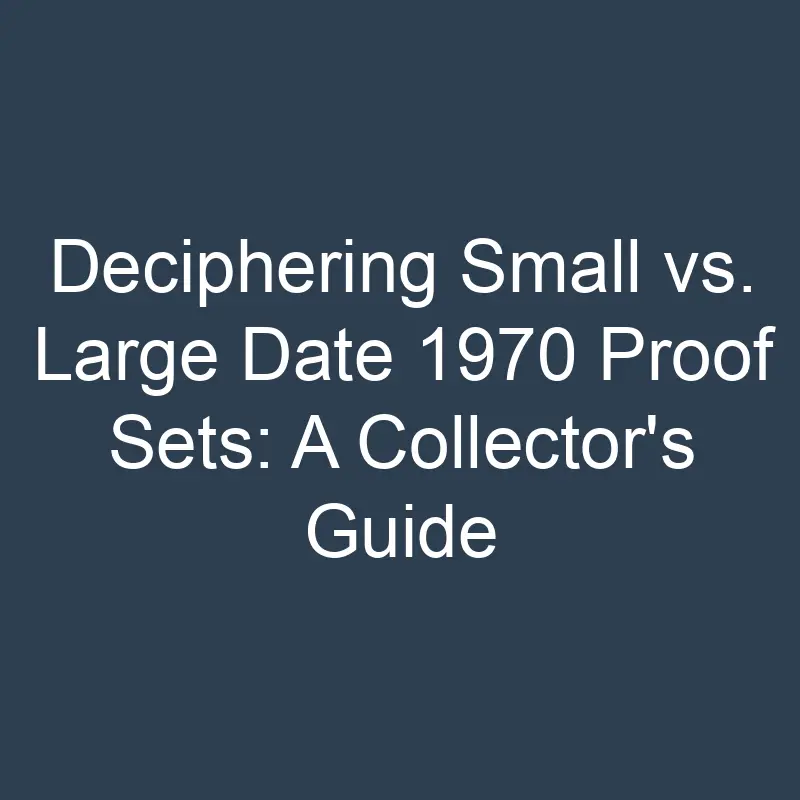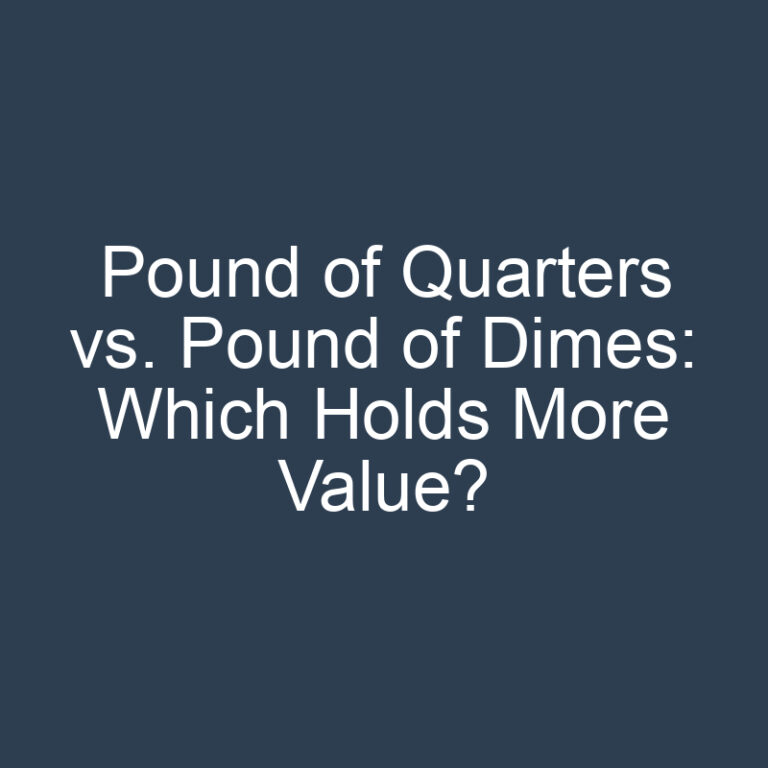
Are you struggling to distinguish between small and large date 1970 proof sets? It’s a common challenge for collectors, but fear not, we’re here to help! Understanding the key differences between these sets is essential for accurately assessing their value and rarity.
When it comes to identifying small versus large date 1970 proof sets, attention to detail is crucial. From the size of the digits to the spacing between them, every aspect plays a role in determining which type of set you have.
In this guide, we’ll walk you through the telltale signs that differentiate small and large date 1970 proof sets, empowering you to make informed decisions and enhance your collecting experience. Let’s dive in and unravel the mysteries behind these fascinating numismatic treasures.
Understanding Small Date and Large Date 1970 Proof Sets
To differentiate between small date and large date 1970 proof sets, we must pay close attention to specific details. The key factors to consider are the size of the digits and the spacing between them. Small date sets feature noticeably smaller digits with less space between the numbers, while large date sets have larger digits with more spacing.
Here is a breakdown to help us identify the characteristics of each type:
- Small Date 1970 Proof Sets:
- Digits are smaller in size.
- Tight spacing between the numbers.
- The top of the 7 in the date aligns with the top of the 9.
- Large Date 1970 Proof Sets:
- Digits are larger compared to small date sets.
- More pronounced spacing between the numbers.
- The top of the 7 in the date does not align with the top of the 9.
By carefully examining these details, we can confidently determine whether a 1970 proof set is a small date or a large date variant. It’s essential to remember that these subtle differences can significantly impact the rarity and value of the set.
Key Differences in Digits Size and Spacing
When differentiating between small date and large date 1970 proof sets, observing the size of the digits and the spacing between numbers is crucial.
Here are the key differences to look out for:
- Small Date Set:
Smaller Digits
Tight Spacing
Top of the 7 aligns with the top of the 9
- Large Date Set:
Larger Digits
More Spacing between Numbers
Carefully examining these features will enable collectors to accurately identify whether they have a small or large date 1970 proof set, significantly impacting its rarity and value.
Analyzing the Mint Mark Variations
When analyzing the mint mark variations on 1970 proof sets, collectors must pay close attention to specific details that distinguish small date sets from large date sets. Mint mark variations can be a key indicator of the set’s rarity and value. Here are some tips to help identify these variations:
- Location: The mint mark on small date sets is closer to the date, while on large date sets, it is further away.
- Shape: Small date sets have a more slanted mint mark, whereas large date sets feature a straighter mint mark.
- Size: The size of the mint mark can also vary, with small date sets typically having a smaller mint mark compared to large date sets.
By carefully examining these mint mark variations, collectors can accurately determine whether they have a small or large date 1970 proof set. This attention to detail is essential in the world of coin collecting, where even the smallest differences can significantly impact the value of a set.
In addition to the mint mark, collectors should also consider other characteristics such as the finish, packaging, and overall condition of the proof set. Combining these factors can further confirm the authenticity and rarity of a small or large date 1970 proof set.
Tips for Identifying Small or Large Date Sets
When examining your 1970 proof set, there are several key factors to consider to differentiate between small date and large date sets. Here are some tips to help you in this process:
- Date Font: Compare the size of the digits in the date. Large date sets typically have larger and more widely spaced numbers.
- Distance from Rim: Check the distance between the base of the 9 in the date and the rim of the coin. In large date sets, there is a noticeable gap compared to small date sets.
- Serif Style: Look closely at the serif style on the numbers. Small date sets have more block-like serifs, whereas large date sets exhibit more pointed serifs.
- Clear Mint Mark: Ensure that the mint mark is clear and distinct. Mint mark variations can also help in distinguishing between small and large date sets.
- Compare with Reference Images: Utilize online resources or reference materials that provide images and details of small and large date sets for visual comparison.
- Consult with Experts: If in doubt, consider seeking advice from experienced coin collectors or numismatists who specialize in 1970 proof sets.
By paying attention to these details, you can enhance your ability to accurately identify whether you have a small date or large date 1970 proof set. Remember, thorough examination is key in determining the rarity and value of your collection.
Evaluating the Value and Rarity Factors
When evaluating the value and rarity factors of small and large date 1970 proof sets, it’s crucial to pay attention to specific details that can significantly impact their worth in the numismatic world. Here are key factors to consider:
- Mint Mark Variations: Examine the mint mark on the coins closely. Discrepancies in the size, position, or clarity of the mint mark can indicate a small or large date variation.
- Date Font and Distance from the Rim: Compare the font of the date on the coins and its distance from the rim. Small date sets often have a different font style and are positioned closer to the rim compared to large date sets.
- Serif Style: Analyze the serif style of the digits in the date. Small date coins typically feature digits with more pronounced serifs, while large date coins have less prominent serifs.
- Clarity of the Mint Mark: Check the clarity of the mint mark, as small date sets tend to have sharper and clearer mint marks compared to their large date counterparts.
By meticulously assessing these factors, collectors can gain valuable insights into the rarity and monetary value of their 1970 proof sets. A small variation in these details can make a significant difference in the overall worth of a coin, making it essential to conduct a thorough evaluation.
Continuously honing our skills in identifying these nuances can enhance our ability to distinguish between small and large date 1970 proof sets accurately. Ultimately, this attention to detail contributes to a deeper understanding of the intricate world of coin collecting and the unique treasures it holds.
Key Takeaways
- Small date 1970 proof sets have smaller digits, tight spacing, and the top of the 7 aligns with the 9, while large date sets have larger digits, more spacing, and the 7 does not align with the top of the 9.
- Mint mark location, shape, and size can help differentiate between small and large date sets, with small date sets having a closer, slanted mint mark.
- Pay attention to details like date font, distance from the rim, serif style, and mint mark clarity to accurately identify small or large date 1970 proof sets.
- Consulting with experts, comparing with reference images, and examining mint mark variations are crucial steps in determining the rarity and value of these proof sets.
Conclusion
Assessing small and large date 1970 proof sets requires a keen eye for detail. By examining mint mark variations, date font, distance from the rim, serif style, and mint mark clarity, we can accurately determine the rarity and value of these sets. Continuous practice and attention to these subtle nuances are essential in distinguishing between the two. Remember, even the slightest differences in these aspects can significantly influence the overall worth of a coin in the numismatic realm. Stay vigilant and keep refining your skills to become adept at identifying the distinctions between small and large date 1970 proof sets.






